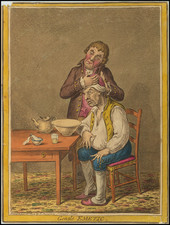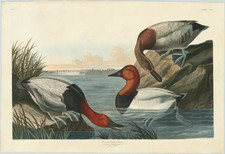Teaching Map Symbols To Children
Decorative copperplate engraving of geographic and cartographic symbols, intended for eduating students.
This exceptional cartographic piece serves as a pedagogical tool, depicting an invented geography teeming with an array of cultural and topographical elements. The purpose of this imaginative map is to educate aspiring cartographers in the nuanced craft of mapmaking. It showcases an extensive assortment of cartographic features—port towns, seats of learning, ecclesiastical buildings, postal routes, fluvial systems, topographic elevations, peninsulas, islets, and beyond.
The cartouche depicted is an intricate allegory of geographical knowledge and exploration. Three personified figures, representing the various aspects of the Earth and heavens, dominate the scene. In the center, a robust figure of a woman, possibly embodying the concept of Geography or Mother Earth, gracefully supports a globe that highlights the eastern hemisphere. Her poised stance and the globe’s prominence signify the centrality of geographical knowledge. To her right stands Neptune, the Roman god of the sea, identifiable by his trident and royal mantle. He symbolizes the ocean's vastness and the era’s maritime explorations. Neptune's dynamic posture and direct gaze suggest a command over the seas, which were crucial for trade and discovery during the time the map was created. On the left, another figure, possibly representing the concept of Science or Astronomy, holds up an armillary sphere, an instrument used by astronomers to model the celestial sphere. This inclusion emphasizes the importance of astronomy in navigation and map-making. Below, the scene transitions from the celestial to the terrestrial with animals possibly representing different continents or aspects of the natural world. These figures are surrounded by lush foliage and land, which transitions to the aquatic realm where Neptune presides.
The symbols include:
Column 1:
- Large City with a Citadel / Lat: Major city with a fortress
- Medium City / Lat: Average city
- Small City / Lat: Minor city
- Market Town / Lat: Municipality
- Large Village / Lat: Country town
- Smaller Village / Lat: Village
- Noble's Seat / Lat: with a noble seat
- with a ruined Castle / Lat: with a destroyed fort
- Imperial Free City / Lat: Imperial city
- Cross Bishopric / Lat: archbishopric
- Bishopric / Lat: Bishopric
- Abbey / Lat: Abbey
- Provostship / Lat: Provostship
- Preceptor / Lat: Prelature
- Governance of Ecclesiastical Princes / Lat: Ecclesiastical principality
- Secular Princely Territory / Lat: Secular principality
- Count's Territories / Lat: Counts and Lords
- Commandery / Lat: Commandery
- University / Lat: University
- Hamlet / Lat: Hamlet
Column 2:
- Mill / Lat: Mill
- Gunpowder Mill / Lat: Gunpowder mill
- Paper Mill / Lat: Paper mill
- Post Station / Lat: Courier station
- Riding Post / Lat: Horse courier
- Carriage Post / Lat: Carriage courier
- County / Lat: Royal domain
- Mountain Castle / Lat: Fortress
- Hunter's Court / Lat: Hunting lodge
- Gold Mine / Lat: Gold mine
- Silver Mine / Lat: Silver mine
- Copper Mine / Lat: Copper mine
- Metal Mine / Lat: Metal mine
- Iron Mine / Lat: Iron mine
- Lead Mine / Lat: Lead mine
- Health Spa / Lat: Medicinal bath
- Healing Spring / Lat: Medicinal spring
- Salt Spring / Lat: Salt spring
- Vineyard / Lat: Vineyard
- Battle / Lat: Battle
Matthäus Seutter (1678-1757) was a prominent German mapmaker in the mid-eighteenth century. Initially apprenticed to a brewer, he trained as an engraver under Johann Baptist Homann in Nuremburg before setting up shop in his native Augsburg. In 1727 he was granted the title Imperial Geographer. His most famous work is Atlas Novus Sive Tabulae Geographicae, published in two volumes ca. 1730, although the majority of his maps are based on earlier work by other cartographers like the Homanns, Delisles, and de Fer.
Alternative spellings: Matthias Seutter, Mathaus Seutter, Matthaeus Seutter, Mattheus Seutter











![[The centre of this Slider is to be placed by a Thread or Pin over the centre of the respective Planisphere for any Operation]](https://storage.googleapis.com/raremaps/img/small/65557.jpg)
![[ Descendants of Noah ] Table historique du second age du monde tiree de la Genese...](https://storage.googleapis.com/raremaps/img/small/82009.jpg)

![[ Danube River Chart ] Naam-Wyser . . . Middel Gedeelte van dem Donau-Stroom, Namekly van de Stad Lintz tot de Stad Viddin . . .](https://storage.googleapis.com/raremaps/img/small/98963.jpg)